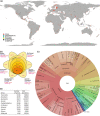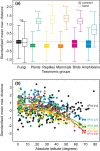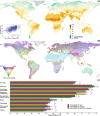Global patterns in endemicity and vulnerability of soil fungi
- PMID: 36056462
- PMCID: PMC9826061
- DOI: 10.1111/gcb.16398
Global patterns in endemicity and vulnerability of soil fungi
Abstract
Fungi are highly diverse organisms, which provide multiple ecosystem services. However, compared with charismatic animals and plants, the distribution patterns and conservation needs of fungi have been little explored. Here, we examined endemicity patterns, global change vulnerability and conservation priority areas for functional groups of soil fungi based on six global surveys using a high-resolution, long-read metabarcoding approach. We found that the endemicity of all fungi and most functional groups peaks in tropical habitats, including Amazonia, Yucatan, West-Central Africa, Sri Lanka, and New Caledonia, with a negligible island effect compared with plants and animals. We also found that fungi are predominantly vulnerable to drought, heat and land-cover change, particularly in dry tropical regions with high human population density. Fungal conservation areas of highest priority include herbaceous wetlands, tropical forests, and woodlands. We stress that more attention should be focused on the conservation of fungi, especially root symbiotic arbuscular mycorrhizal and ectomycorrhizal fungi in tropical regions as well as unicellular early-diverging groups and macrofungi in general. Given the low overlap between the endemicity of fungi and macroorganisms, but high conservation needs in both groups, detailed analyses on distribution and conservation requirements are warranted for other microorganisms and soil organisms.
Keywords: biodiversity; biogeography; climate change; conservation priorities; global change vulnerability; global maps; mycorrhizal fungi; pathogens; saprotrophs.
© 2022 The Authors. Global Change Biology published by John Wiley & Sons Ltd.
Conflict of interest statement
The authors declare no competing interests.
Figures






References
-
- Aslani, F. , Geisen, S. , Ning, D. , Tedersoo, L. , & Bahram, M. (2022). Towards revealing the global diversity and community assembly of soil eukaryotes. Ecology Letters, 25, 65–76. - PubMed
-
- Bach, E. M. , Ramirez, K. S. , Fraser, T. D. , & Wall, D. H. (2020). Soil biodiversity integrates solutions for a sustainable future. Sustainability, 12, 2662.
-
- Bahram, M. , Hildebrand, F. , Forslund, S. K. , Anderson, J. L. , Soudzilovskaia, N. A. , Bodegom, P. M. , & Bork, P. (2018). Structure and function of the global topsoil microbiome. Nature, 560, 233–237. - PubMed
-
- Bahram, M. , Koljalg, U. , Courty, P. E. , Diedhiou, A. G. , Kjøller, R. , Polme, S. , Ryberg, M. , Veldre, V. , & Tedersoo, L. (2013). The distance decay of similarity in communities of ectomycorrhizal fungi in different ecosystems and scales. Journal of Ecology, 101, 1335–1344.
MeSH terms
Substances
LinkOut - more resources
Full Text Sources

